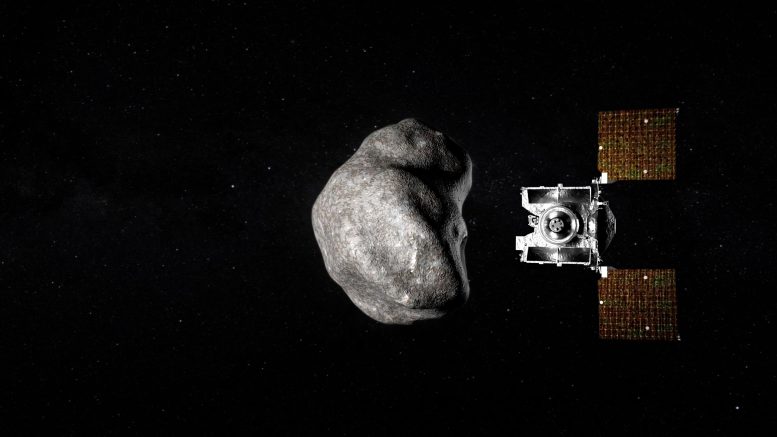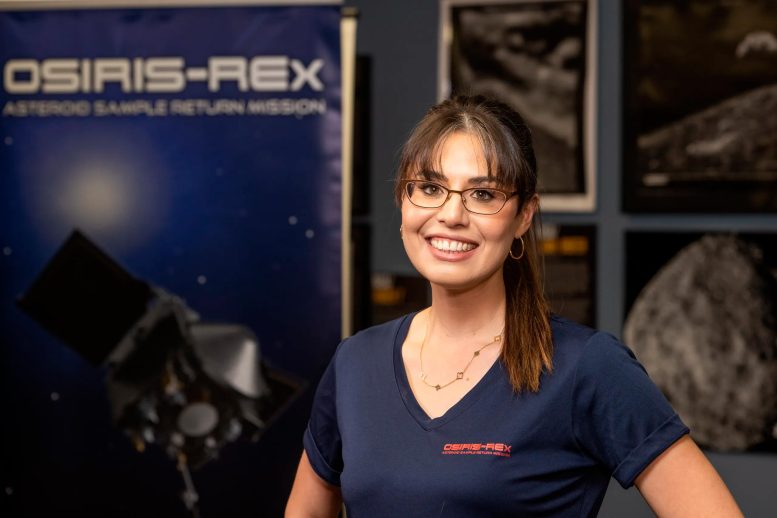OSIRIS-APEX pursues asteroid Apophis during its exceptionally close flyby of Earth on April 13, 2029. Credit: NASA’s Goddard Space Flight Center Conceptual Image Lab
NASA’s OSIRIS-REx mission learned much about the potentially hazardous asteroid Bennu and its risk to Earth. Now, the mission will change hands and target a different kind of potentially hazardous asteroid, Apophis.
After seven years in space and over 4 billion miles traveled, NASA’s OSIRIS-REx mission successfully collected and delivered the first U.S. sample from a near-Earth asteroid. Yet, after all this time and travel, the spacecraft will not retire.
Instead, NASA extended the University of Arizona-led mission so that the spacecraft can be used to study another near-Earth asteroid named Apophis. The mission was renamed OSIRIS-APEX, short for OSIRIS-APophis EXplorer. An overview of the mission was published in the Planetary Science Journal.
OSIRIS-REx deputy principal investigator Dani DellaGiustina is now the principal investigator for the OSIRIS-APEX mission.
Dani DellaGiustina, principal investigator for the OSIRIS-APEX mission. Credit: Christopher Richards/University of Arizona
Encounter with Apophis
Twenty minutes after dropping the sample high above Earth’s atmosphere on September 24, the spacecraft fired its thrusters to put it on course to rendezvous with Apophis in 5½ years – just after Apophis makes its own close approach to Earth. This path includes three Earth gravity assists and several nail-bitingly close laps around the sun.
By April 2, 2029, the spacecraft cameras will begin collecting data as it approaches the asteroid. Apophis will also be closely observed by Earth-based telescopes. But in the hours after the close encounter, Apophis will appear too near the sun in the sky to be observed by Earth-based optical telescopes. This means any changes triggered by the close encounter will be best detected by spacecraft.
The spacecraft will catch up to the asteroid on April 13, 2029, as the asteroid wizzes 20,000 miles above Earth’s surface. Scientists will then spend the next 18 months studying the asteroid in detail. They’ll also disturb the material on the surface with the spacecraft to reveal what lies just beneath.
The Infamy of Apophis
“Apophis is an infamous asteroid,” said DellaGiustina, who is an assistant professor of planetary sciences at the University of Arizona’s Lunar and Planetary Laboratory. “When it was discovered in 2004, there was a scare that it was going to impact the Earth in 2029, but that risk was retired. Then there was another scare that it was going to impact the Earth exactly seven years later, in 2036, but observations combined with modeling now show that Apophis doesn’t pose a risk for at least the next one hundred years. Despite this, Apophis still has this role in the psyche of all of us who study these things. While it’s not going to impact the Earth in 2029, however, it does get very close.”
The 340-meter-wide Apophis is a stony, or S-type, asteroid made of silicate materials and nickel-iron, which are different than C-type asteroids like OSIRIS-REx’s first target, Bennu, which are rich in carbonaceous material. Apophis likely formed from a collision of a parent body in the asteroid belt that knocked it toward Earth’s neighborhood. The asteroid will pass closer than some of Earth’s orbiting satellites and one-tenth the distance to the moon. This is the closest approach by an asteroid of this size in modern history, and it will be visible to the naked eye in the Eastern Hemisphere. An asteroid of this size coming so close to Earth is rare, occurring roughly once every 7,500 years.
Selecting the Next Target
The mission considered visiting other targets – even Venus – but Apophis was chosen, because it was the only object that the spacecraft could closely rendezvous with, DellaGiustina said. The close approach allows scientists to study interactions with Earth’s gravitational forces, specifically tidal forces that could disturb its surface to reveal what lies beneath.
“Apophis gets close enough that there is some amount of activity that we are anticipating on its surface,” DellaGiustina said. “There might be landslides or particle ejections that create a comet-like tail. The close approach is a great natural experiment.
“We know that tidal forces and the accumulation of rubble pile material are foundational processes that could play a role in planet formation. They could inform how we got from debris in the early solar system to full-blown planets. Our best guess right now is that Apophis is, indeed, a rubble pile.”
Mission science goals are based on what is known about Apophis from ground-based observations, the team’s experiences at Bennu and current data for other S-type asteroids. Ultimately, the team hopes to understand the asteroid’s evolution and characteristics, including Apophis’ material strength, porosity, and density. All they learn can inform planetary defense research, especially because most of the potentially hazardous asteroids are also S-type asteroids like Apophis.
Bridging Meteorites and Asteroids
“We learned a lot at Bennu, but now we’re armed with even more questions,” said Amy Simon, OSIRIS-APEX mission project scientist and senior scientist for Planetary Atmospheres Research in the Solar System Exploration Division at the NASA Goddard Space Flight Center.
For example, as deputy instrument scientist for the OSIRIS-REx Visible and near-IR Spectrometer, Simon and colleagues detected clay minerals and organics on Bennu, suggesting that the asteroid interacted with water in the past. Scientists predicted finding these on C-type asteroids like Bennu but were unable to detect it from ground-based observations.
Simon said she’s excited to see how Apophis looks different from expectations and from carbonaceous asteroids Bennu and Ryugu, which Japan visited with the Hayabusa 2 probe in 2018.
Getting up close and personal with these asteroids presents a unique opportunity for planetary scientists. Currently, scientific understanding of solar system formation is heavily informed by meteorites, which are pieces of other celestial bodies that fall to Earth. Asteroids are the primary parent bodies of meteorites but are usually observed from so far away that they appear only as points of light in the sky that reveal little about their global properties or surface variability.
The OSIRIS spacecraft science instruments were specifically designed to connect our understanding of meteorites to their parent asteroids by placing meteorite-scale rocks into geologic context on asteroids and investigating asteroids’ geologic processes at Bennu and very soon at Apophis.
Reference: “OSIRIS-APEX: An OSIRIS-REx Extended Mission to Asteroid Apophis” by Daniella N. DellaGiustina, Michael C. Nolan, Anjani T. Polit, Michael C. Moreau, Dathon R. Golish, Amy A. Simon, Coralie D. Adam, Peter G. Antreasian, Ronald-Louis Ballouz, Olivier S. Barnouin, Kris J. Becker, Carina A. Bennett, Richard P. Binzel, Brent J. Bos, Richard Burns, Nayessda Castro, Steven R. Chesley, Philip R. Christensen, M. Katherine Crombie, Michael G. Daly, R. Terik Daly, Heather L. Enos, Davide Farnocchia, Sandra Freund Kasper, Rose Garcia, Kenneth M. Getzandanner, Scott D. Guzewich, Christopher W. Haberle, Timothy Haltigin, Victoria E. Hamilton, Karl Harshman, Noble Hatten, Kyle M. Hughes, Erica R. Jawin, Hannah H. Kaplan, Dante S. Lauretta, Jason M. Leonard, Andrew H. Levine, Andrew J. Liounis, Christian W. May, Laura C. Mayorga, Lillian Nguyen, Lynnae C. Quick, Dennis C. Reuter, Bashar Rizk, Heather L. Roper, Andrew J. Ryan, Brian Sutter, Mathilde M. Westermann, Daniel R. Wibben, Bobby G. Williams, Kenneth Williams and C. W. V. Wolner, 31 October 2023, The Planetary Science Journal.
DOI: 10.3847/PSJ/acf75e
>>> Read full article>>>
Copyright for syndicated content belongs to the linked Source : SciTechDaily – https://scitechdaily.com/encounter-with-infamy-osiris-apex-mission-sets-sights-on-the-notorious-asteroid-apophis/

































